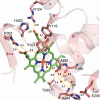Crystal structures of Trypanosoma brucei sterol 14alpha-demethylase and implications for selective treatment of human infections
- PMID: 19923211
- PMCID: PMC2804335
- DOI: 10.1074/jbc.M109.067470
Crystal structures of Trypanosoma brucei sterol 14alpha-demethylase and implications for selective treatment of human infections
Abstract
Sterol 14alpha-demethylase (14DM, the CYP51 family of cytochrome P450) is an essential enzyme in sterol biosynthesis in eukaryotes. It serves as a major drug target for fungal diseases and can potentially become a target for treatment of human infections with protozoa. Here we present 1.9 A resolution crystal structures of 14DM from the protozoan pathogen Trypanosoma brucei, ligand-free and complexed with a strong chemically selected inhibitor N-1-(2,4-dichlorophenyl)-2-(1H-imidazol-1-yl)ethyl)-4-(5-phenyl-1,3,4-oxadi-azol-2-yl)benzamide that we previously found to produce potent antiparasitic effects in Trypanosomatidae. This is the first structure of a eukaryotic microsomal 14DM that acts on sterol biosynthesis, and it differs profoundly from that of the water-soluble CYP51 family member from Mycobacterium tuberculosis, both in organization of the active site cavity and in the substrate access channel location. Inhibitor binding does not cause large scale conformational rearrangements, yet induces unanticipated local alterations in the active site, including formation of a hydrogen bond network that connects, via the inhibitor amide group fragment, two remote functionally essential protein segments and alters the heme environment. The inhibitor binding mode provides a possible explanation for both its functionally irreversible effect on the enzyme activity and its selectivity toward the 14DM from human pathogens versus the human 14DM ortholog. The structures shed new light on 14DM functional conservation and open an excellent opportunity for directed design of novel antiparasitic drugs.
Figures





Similar articles
-
Sterol 14alpha-demethylase (CYP51) as a therapeutic target for human trypanosomiasis and leishmaniasis.Curr Top Med Chem. 2011;11(16):2060-71. doi: 10.2174/156802611796575902. Curr Top Med Chem. 2011. PMID: 21619513 Free PMC article. Review.
-
Structural complex of sterol 14α-demethylase (CYP51) with 14α-methylenecyclopropyl-Delta7-24, 25-dihydrolanosterol.J Lipid Res. 2012 Feb;53(2):311-20. doi: 10.1194/jlr.M021865. Epub 2011 Nov 30. J Lipid Res. 2012. PMID: 22135275 Free PMC article.
-
Homology modeling of lanosterol 14alpha-demethylase of Candida albicans and Aspergillus fumigatus and insights into the enzyme-substrate Interactions.J Biomol Struct Dyn. 2004 Aug;22(1):91-9. doi: 10.1080/07391102.2004.10506984. J Biomol Struct Dyn. 2004. PMID: 15214809
-
Dynamics of CYP51: implications for function and inhibitor design.J Mol Recognit. 2015 Feb;28(2):59-73. doi: 10.1002/jmr.2412. Epub 2015 Jan 20. J Mol Recognit. 2015. PMID: 25601796 Free PMC article.
-
Targeting Trypanosoma cruzi sterol 14α-demethylase (CYP51).Adv Parasitol. 2011;75:65-87. doi: 10.1016/B978-0-12-385863-4.00004-6. Adv Parasitol. 2011. PMID: 21820552 Free PMC article. Review.
Cited by
-
Structural diversity of eukaryotic membrane cytochrome p450s.J Biol Chem. 2013 Jun 14;288(24):17082-90. doi: 10.1074/jbc.R113.452805. Epub 2013 Apr 30. J Biol Chem. 2013. PMID: 23632020 Free PMC article. Review.
-
Concerning P450 Evolution: Structural Analyses Support Bacterial Origin of Sterol 14α-Demethylases.Mol Biol Evol. 2021 Mar 9;38(3):952-967. doi: 10.1093/molbev/msaa260. Mol Biol Evol. 2021. PMID: 33031537 Free PMC article.
-
Human sterol 14α-demethylase as a target for anticancer chemotherapy: towards structure-aided drug design.J Lipid Res. 2016 Aug;57(8):1552-63. doi: 10.1194/jlr.M069229. Epub 2016 Jun 16. J Lipid Res. 2016. PMID: 27313059 Free PMC article.
-
Microbial cytochromes P450: biodiversity and biotechnology. Where do cytochromes P450 come from, what do they do and what can they do for us?Philos Trans R Soc Lond B Biol Sci. 2013 Jan 6;368(1612):20120476. doi: 10.1098/rstb.2012.0476. Print 2013 Feb 19. Philos Trans R Soc Lond B Biol Sci. 2013. PMID: 23297358 Free PMC article. Review.
-
Azole affinity of sterol 14α-demethylase (CYP51) enzymes from Candida albicans and Homo sapiens.Antimicrob Agents Chemother. 2013 Mar;57(3):1352-60. doi: 10.1128/AAC.02067-12. Epub 2012 Dec 28. Antimicrob Agents Chemother. 2013. PMID: 23274672 Free PMC article.
References
-
- Barrett M. P., Burchmore R. J., Stich A., Lazzari J. O., Frasch A. C., Cazzulo J. J., Krishna S. (2003) Lancet 362, 1469–1480 - PubMed
-
- Croft S. L., Barrett M. P., Urbina J. A. (2005) Trends Parasitol. 21, 508–512 - PubMed
-
- Soeiro M. N., de Castro S. L. (2009) Expert. Opin. Ther. Targets 13, 105–121 - PubMed
-
- Lüscher A., de Koning H. P., Mäser P. (2007) Curr. Pharm. Des. 13, 555–567 - PubMed
Publication types
MeSH terms
Substances
Associated data
- Actions
- Actions
Grants and funding
LinkOut - more resources
Full Text Sources
Other Literature Sources

